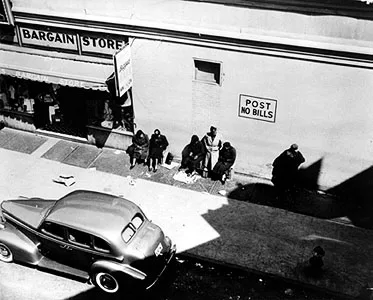“Automation replaces men. This is of course nothing new,” explains James Boggs in his 1963 treatise The American Revolution: Pages from a Negro Worker’s Notebook. “What is new is that now, unlike most earlier periods, the displaced men have nowhere to go.”1 This was particularly true for the many Black workers who, like Boggs, had migrated from the Jim Crow South to the northern cities in search of gainful employment during the postwar period. Unable to find meaningful work and with return to the South not an option, they remained trapped in urban ghettos with little hope for economic improvement. Importantly, Boggs believed that not only low- and un-skilled labor were threatened by automation, but that office workers too would find their places taken “by IBM machines and computers.” Under such conditions of generalized precarity, government schemes to educate and retrain workers were already outmoded as soon as they were planned, because “as fast as they are trained for a higher technical stage of production, just as fast does a new technical revolution take place.” Indeed, in 1964, just one year after Boggs, Martin Luther King Jr. warned that many unskilled and semi-skilled jobs—to which Black Americans had by and large been restricted—were in danger of being eradicated by “the forces of automation and cybernation.”
As automation caused these numbers of the unemployed to swell—Boggs believed—they began to constitute a “revolutionary force or army of outsiders and rejects who are totally alienated from this society.” As he argued, the dilemma of these “outsiders” marked the dilemma of American society writ large: that automation “excludes more and more people from playing any productive role in society” and that there was no clear means of supporting individuals who were made obsolete.
Such warnings about technological unemployment are being repeated now, but at an entirely new order of magnitude. In July 2023, the McKinsey Global Institute released a report on generative AI and the future of work in the United States.2 Like much recent writing about AI, the report mixed technological optimism with concern about emerging vulnerabilities. While praising the economic growth that new technologies might fuel, the report also warns about the growing challenges for some of the most marginalized workers in the economy. The future of work, it predicts, will increasingly shrink demand in occupations within customer service, food services, and production work, areas in which Black Americans are highly concentrated.
Such predictions extend concerns that have emerged among economic forecasters in recent years that the “job-stealing robots” might create further hardships for already vulnerable racial minority workers. The emerging consensus among management consultants, Silicon Valley leaders, and policymakers—that meeting these challenges simply requires training more Black workers in programming and other skills valued in the tech industry—seems so self-evident as to be almost unremarkable, reflecting a particularly American ideology beholden to the view that technological progress is inevitable and that workers must improve themselves or be swept aside by its inexorable march. Such an individualizing approach to technological displacement, however, belies a myopia that has characterized US technological policy for decades—particularly when it intersects with issues of economic and racial justice.
What thinkers like Boggs understood—and which the McKinsey report fails to grasp—is that automation is fundamentally a political problem. As the history of American labor policy shows, efforts to train Black workers in tech skills are inadequate and only trap them in a race to the bottom to sell their labor. What is required instead is to shift how we think about technology, work, and social worth.
As early as the 1960s, debates about the consequences of technological progress have provided a platform for those wishing to declaim on the political and economic future of Black America. During that decade in particular, automation anxieties were a forceful presence in the US political landscape. Throughout his time in the Senate and his presidency, John F. Kennedy declaimed technological unemployment as “the major domestic challenge of the sixties” and urged the need to retain “full employment at a time when automation … is replacing men.”3
To address this challenge, Kennedy signed the Manpower Development and Training Act (MDTA) in 1962, the first major federal legislation aimed at assisting workers displaced by automation (or in danger of being displaced). Between 1963 and 1972, the MDTA served nearly two million Americans through institutional classroom training and on-the-job training, provided by employers who received federal subsidies from the US Department of Labor. The early programs under the bill targeted workers like elevator operators, who were being displaced by driverless elevators, and others whose jobs were threatened by new technologies. Over the course of the 1960s, MDTA shifted their focus to serving impoverished Americans and racial minority groups, who were in danger of being barred entry to the labor market by the dual forces of racial discrimination and technological unemployment.
These efforts to train automation-threatened Americans intersected with the nascent civil rights movement. Many Black Americans lacked the formal qualifications for employment in the expanding white-collar professions and faced additional barriers to gainful employment due to lack of educational opportunities, poverty, and racial discrimination. As such, automation anxiety became an offshoot of the more general concerns about the economic future of Black Americans for many civil rights leaders.
So linked were the future of automation and of Black Americans that in 1964, Whitney Young, executive director of the civil rights organization the National Urban League, described the civil rights movement and automation as “intermingled revolutions” that would shape the future of the United States and its Black citizens. If the civil rights movement was to realize its aspirations of racial equality, Young argued, the United States needed to prevent automation from permanently rendering most Black Americans unemployed.
The 1964 uprisings in Harlem, Rochester, and Philadelphia—blamed in the press on unemployed and socially alienated Black youths—spurred calls to reevaluate how such manpower programs were serving Black Americans. The Labor Department began concentrating manpower programs in predominantly Black communities, including urban ghettos in New York and Los Angeles, along with rural areas like the Mississippi Delta. These projects were organized around a goal that manpower officials had pursued since the passage of the MDTA: the prospect of “upgrading” workers.
Proponents of automation had long heralded the opportunity that technological innovations afforded to “upgrade” the average American’s working skills. John Diebold, a leading voice of technological optimism in the postwar United States, had proclaimed in 1952:
Automation will mean that human labor in the advanced technological societies will be used less and less for the routine, repetitive functions involved in feeding workpieces through machines and assembling them into finished products. Labor will be more and more “up-graded” into the kinds of functions performed by the engineer, the designer, the production planner, the skilled maintenance and repair man, the organizer and manager.4
As applied to Black manpower projects, however, “upgrading” took on the form of paternalistic racial uplift, emphasizing self-reliance, temperance, thrift, and moral purity as the keys to racial progress in an automated society.
The stated goal of a manpower development project among Black residents in the Mississippi Delta, for example, was to “cultivate the hope that died years ago in a man or woman” through vocational training, basic education, IQ testing, psychiatric services, and instruction in various topics including “personal hygiene, venereal disease, and family planning.” Such rhetoric clashed with local economic and technological realities. In the delta, the economic elite had weaponized the technologies of postwar agricultural mechanization, chemical fertilizers, and pesticides to dismantle the growing economic and political strength of Black labor. Consequently, the few opportunities that existed for Black farmers consisted almost exclusively of low-wage, low-skill forms of work. Among delta manpower trainees, a person trained as a production machine operator found work as a construction worker, an automobile mechanic as a maintenance person, and a clerk-stenographer as a woodworking machine operator.
The majority returned to seasonal farmwork before even completing their training. In essence, manpower projects trained people for jobs that simply did not exist.
These programs also marked a shift away from civil rights leaders’ original hope for automation policy to advance racial equality. Instead, they enacted a racialized hierarchy of technological work.
This was best evinced in efforts to train Black workers in computer programming and data processing. MDTA provided a $49,000 grant to the Institute of Computer Technology, a nonprofit offshoot of the Datatrol Corporation, to provide computer training for unemployed and underemployed residents of the Washington DC metropolitan region. This effort was dubbed Project PREPARE (Plan for Retraining of Employable Persons as Related to EDP [Electronic Data Processing]). Training Black workers in electronic data processing (EDP) was one of the central concerns of manpower policy, and projects like PREPARE often enlisted the expertise of private companies, who promised trainees the opportunity to “program new lives” for them.
PREPARE’s curriculum was organized into three phases, with classroom facilities and machine time offered by IBM at its education center in Silver Spring, Maryland. During phase A-1, trainees learned the basic concepts and vocabulary of computing and worked with electronic accounting machines (EAM) for ten weeks. At the end of the phase, they took IBM computer programming aptitude tests. Those showing a greater aptitude for programming progressed to phase B-1, where they developed specializations in early computing languages. All of the rest of the trainees progressed to phase A-2, where they continued working with EAM. Both phases A-2 and B-1 lasted 20 weeks.
Between 1964 and 1967, PREPARE graduated about 100 students—65 percent of whom were Black—and a majority of whom had a high school education or less when they enrolled in the program. The success of the initial program led the Labor Department to pour more funds into it, allowing the Institute for Computer Training to open up campuses in several metropolitan regions. As with many other MDTA projects, training extended beyond learning new skills to reforming enrollees’ appearance and behavior. The New York Amsterdam News, the city’s largest Black newspaper, celebrated the story of “Ms. A.G.,” a 33-year-old welfare recipient who enrolled at the institute after reading a story about it in the paper. In addition to training her to be a keypunch operator, the institute recognized a need for “adequate career clothing and beauty culture to improve her appearance,” and provided Ms. A.G. with a new wardrobe, hair style, and cosmetics—“and a new person was born.”5 While such experiences likely helped some trainees develop positive self-esteem and find new careers, they were reinforced pejorative notions of Black cultural pathology that located the cause of racial inequality in individual behavior.
Anxiety over automation can pit working people against one another in a race to learn new skills. Instead, we should demand that technological innovation be put toward the business of human flourishing.
Furthermore, while completion of the program provided many of the graduates with new opportunities to enter the growing labor market for computer workers, their role was always envisioned as a subordinate one. This was due in part to the nature of computer programming, which was believed to be especially suited to Black workers. After all, Secretary of the Labor Department Willard Wirtz pointed out, formal educational attainment was “not a prerequisite for this type of course, as long as aptitudes, basic abilities and personal desire match the demands of the course.” Wirtz argued that graduates of Project Prepare and similar training efforts, who lacked degrees and more formal training in data processing, could take on the role of “skilled subprofessionals who can relieve highly trained engineers and computer specialists from routine duties.”
On the one hand then, training sought to confer onto Black workers the skills necessary for taking on basic kinds of data-processing jobs. At the same time, their inclusion into the automating economy was almost always envisioned in second-class or subordinate roles. In this way, manpower policy proved remarkably prescient: envisioning a racialized division of computational labor that maps on to our present moment. Today, marginalized workers across the globe perform rote and routine computational piecework (on platforms like Amazon’s Mechanical Turk), labor that is often low-wage, unheralded, and invisible to the casual observer.
By 1973, the MDTA was no more, having been replaced with the Comprehensive Employment and Training Act (CETA), which delegated more power and resources to state officials to shape the training programs offered to the unemployed. While the law lasted only ten years, it marked a significant turning point toward governing technological change through focusing on individuals’ working abilities and their technical skills. Rather than a relic of the era of “big government” welfare policy, as the MDTA has been interpreted in much of the literature, it should more properly be seen as an antecedent to the technological utopianism of later projects that have sought to increase the nation’s technological literacy, bridge “skills gap” and “digital divides”—or indeed, to train Black AI workers.
Such projects, argues Morgan G. Ames, typically have “plunked technologies and engineering projects down in impoverished regions with expectations of easy cultural transformation instead of plans for support or maintenance.”6 They are often incapable of addressing the underlying economic problems that marginalized communities face. This raises the question: How else might we grapple with the challenges of technological change?
Throughout the 1960s, radical theorists pitched their own visions of technological change and what to do about it. None was more influential than James Boggs.
Born in 1919 in Jim Crow Alabama, Boggs migrated to Detroit in the 1930s, finding work at a Chrysler plant and there joining the United Auto Workers local. As a Black worker in Detroit’s auto industry, Boggs witnessed firsthand how new electronic controls displaced workers from the assembly line, and also observed the failures of management, government leaders, and the labor movement itself to address the disruptions caused by automation. In his critical writings, Boggs argued that their failure to conceive of an adequate solution to the automation-unemployment problem stemmed from the one belief they all held in common: that individuals must work.
For Boggs, the path forward in the age of automation would not be the struggle for full employment, but rather the acceptance of full unemployment: the creation of a society without work. If American society was to adequately address the challenge of the outsiders, he argued, “the question of the right to a full life has to be divorced completely from the question of work.” This meant easing workers out of manufacturing jobs that could be done more cheaply machines, while still guaranteeing them a full, livable income. This, he believed, was the path to a freer and more equal society, in which human value was based not on the job that one worked, but on their “value as a human being.”
What lessons might Boggs’s work hold for us today, on the cusp of what some predict will be an artificial intelligence revolution? Crucially, his arguments point toward the flaw in the recommendations of the McKinsey report and other contemporary forecasts that point to the need for American workers to develop new skills in order to keep up with changing technologies.
Retraining workers can be an important temporary measure. But it will only ever be a stop-gap solution to the broader political-economic problems underlying technological change. Presenting it as the only path forward distracts from finding more effective ways of securing a better future for those at the margins of American society, such as experimenting with universal basic income or with reimagining the welfare state for the 21st century.
Anxiety over automation can pit working people against one another in a race to learn new skills. Instead, we should demand that technological innovation be put toward the business of human flourishing. ![]()
This article was commissioned by Mona Sloane.





